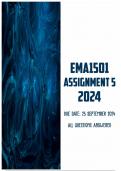Exam (elaborations)
EMA1501 Assignment 5 2024 | Due 25 September 2024
- Institution
- University Of South Africa (Unisa)
EMA1501 Assignment 5 2024 | Due 25 September 2024. All questions answered. QUESTION 1: PRE-NUMBER CONCEPTS (25) Read the statement below and answer the questions that follow. From birth already, children are exposed to mathematical concepts and activities. For example, when feeding a baby, a m...
[Show more]



